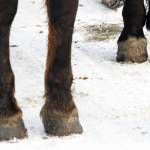Treating Sesamoid Injuries in Horses

At the rear side of the pastern on each equine limb are two small sesamoid bones that provide anchor points for the two branches of the suspensory ligament. As elements of the pastern joint, the sesamoids are under stress each time the horse takes a step.
Like other parts of the horse’s skeleton, these bones respond to weight-bearing and become stronger as the horse exercises, but this is a gradual process that takes time. Moving ahead too fast with a young horse’s training program can lead to fractures in the sesamoid bones if conditioning lags behind the demands of strenuous exercise. Conformation faults and shoeing problems can also be contributing factors if a horse develops a problem with a sesamoid bone. Likewise, lameness in the opposite leg can make a horse put more weight on the sound leg, increasing stress on bones and tendons.
Unlike some other areas that reveal developing problems by showing heat and tenderness, there may be no indication of lameness before a sesamoid fracture occurs. Diagnosis of a sesamoid fracture is sometimes difficult because the crack is hard to see on a radiograph. Images taken a week or two later may show the fracture more clearly as healing is beginning to take place. Standing MRI scans can be used to detect a sesamoid fracture soon after it occurs.
Treatment for a fractured sesamoid depends somewhat on what part of the bone is broken. Fractures at the top of the bone can sometimes be treated by surgically removing the broken tip, while breaks in the middle or bottom part of the bone have a less positive prognosis. If the bone has broken into several small pieces, repair is rarely successful and affected horses are often euthanized.
For fractures with a good chance of healing so that the horse will be at least pasture-sound, stall rest for 30 to 60 days is the first step in treatment. After the bone heals, the horse can be returned to exercise, starting with hand-walking and limited turnout and progressing very gradually to ridden exercise. Full recovery takes around four months after which the horse may be able to resume training, often at a lower level than the original program.
DuraPlex, a dietary supplement developed by Kentucky Equine Research, provides specific proteins, vitamins, and minerals scientifically proven to increase bone mineral density and bone area in performance horses. By providing specialized postsurgical nutritional support, DuraPlex influences skeletal metabolism by stimulating bone production and suppressing destruction of skeletal cells. DuraPlex is available in the U.S.; Australian clients can look for Bone Food Plus, a similar product.








